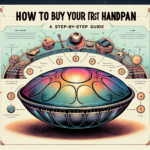The handpan is a beautiful and relatively new musical instrument that has captured the hearts of musicians and listeners alike since its introduction in the early 2000s. Characterized by a resonant and ethereal sound, the handpan’s unique tonal quality is the result of meticulous tuning processes. This article explores both traditional tuning techniques and modern innovations that have shaped the evolution of handpan tuning over the years.
Traditional Tuning Techniques
Traditional handpan tuning methods have their roots in the early days of handpan creation. The process is intricate and requires a deep understanding of both the instrument and the physics of sound. Here are some of the traditional techniques used:
Pounding
This is the most fundamental method of tuning a handpan. The tuner uses a hammer to shape and adjust each note by pounding the metal surface. Precise blows are delivered to create the desired pitch and harmonic overtones. This technique requires not only skill and patience but also a sensitive ear to distinguish subtle changes in tone.
Shaping
Shaping involves adjusting the handpan’s surface to refine its tonal qualities. Tuners use various tools such as plastic mallets, rollers, and anvils to smooth out and shape the metal. This step is crucial for ensuring that the instrument produces a clean and resonant sound across its entire surface.
Heat Treatment
Heat treatment, also known as tempering, is essential for achieving the desired pitch stability and tone quality. By heating and cooling the metal, tuners can relieve internal stresses and enhance the material’s resiliency. This process also helps prevent the metal from warping and ensures the notes remain stable over time.
Modern Innovations in Tuning
While traditional techniques remain invaluable, modern innovations have introduced new dimensions to handpan tuning. Advances in technology and materials have allowed for more precise and efficient tuning processes.
Laser Tuning
Laser tuning is a cutting-edge method that uses precision lasers to measure and adjust the frequencies of handpan notes. This technique offers unparalleled accuracy, allowing tuners to achieve exact pitches and harmonic overtones. Laser tuning also has the advantage of being non-invasive, which means the integrity of the material is maintained.
Computer-Aided Tuning
With the advent of sophisticated software, tuners can now use computer-aided tools to analyze and adjust the tonal properties of a handpan. These programs can provide detailed spectral analyses, making it easier to identify and correct inconsistencies. Computer-aided tuning is particularly useful for achieving complex scales and custom tunings.
Advanced Materials
Modern handpans often incorporate advanced materials such as stainless steel and nitrided steel. These materials offer superior durability and tonal stability compared to traditional steel. The use of advanced materials has also expanded the range of possible sounds, allowing for a greater variety of musical expressions.
Blending Traditional and Modern Techniques
The best handpan tuners often blend traditional methods with modern innovations to achieve the finest results. By combining the sensitivity and craftsmanship of traditional techniques with the precision and efficiency of modern tools, tuners can create instruments that are both artistically and acoustically superior.
For example, a tuner might begin with traditional pounding and shaping techniques to establish the basic tonal characteristics of the handpan. Once a rough tuning is achieved, modern tools such as laser measurements and computer analyses can be employed to refine and perfect the instrument’s sound. This hybrid approach leverages the strengths of both worlds to produce handpans of exceptional quality.
The Future of Handpan Tuning
The field of handpan tuning continues to evolve, driven by both technological advancements and a growing community of passionate tuners and musicians. Innovations such as 3D printing and artificial intelligence could further revolutionize the tuning process, making it even more precise and accessible.
3D printing, for instance, could allow for the creation of highly customized handpans with unique shapes and tonal properties. Meanwhile, AI algorithms could analyze and predict the acoustic outcomes of various tuning techniques, providing valuable insights for tuners. As these technologies mature, we can expect even more exciting developments in the world of handpan tuning.
Conclusion
Handpan tuning is both an art and a science, requiring a delicate balance of traditional craftsmanship and modern technology. While traditional techniques such as pounding, shaping, and heat treatment remain fundamental, modern innovations like laser tuning, computer-aided analyses, and advanced materials have opened new horizons. By blending these methods, tuners can create handpans that are both acoustically superior and artistically unique.
As the handpan community continues to grow and evolve, so too will the techniques and tools used in tuning. Whether you are a musician, a tuner, or simply an enthusiast, the journey of discovering the magic behind handpan tuning is a rewarding and endlessly fascinating endeavor.
FAQs
1. What is the most challenging aspect of handpan tuning?
The most challenging aspect of handpan tuning is achieving the perfect balance of pitch and harmonic overtones. This requires a highly skilled ear and a deep understanding of both the instrument and the physics of sound. Minor adjustments can significantly impact the overall tonal quality, making precision essential.
2. How long does it take to tune a handpan?
Tuning a handpan can take anywhere from several hours to several days, depending on the complexity of the tuning and the skill of the tuner. The process involves multiple stages, including pounding, shaping, heat treatment, and fine-tuning. Each stage requires careful attention to detail to ensure the highest quality sound.
3. Can handpans go out of tune?
Yes, handpans can go out of tune over time, especially if they are subjected to physical impacts or extreme temperature changes. Regular maintenance and careful handling can help preserve the instrument’s tuning. Some modern handpans made from advanced materials are more resilient and less prone to detuning.
4. Are there different scales or tunings available for handpans?
Yes, handpans can be tuned to a variety of scales and tunings, including major, minor, pentatonic, and exotic scales. Tuners can also create custom scales to suit individual musical preferences. This versatility allows musicians to explore a wide range of musical styles and expressions.
5. Can I learn to tune a handpan myself?
While it is possible to learn handpan tuning, it is a highly specialized skill that requires significant training and practice. Many professional tuners spend years honing their craft. If you are interested in learning, it is recommended to seek guidance from experienced tuners and start with a solid understanding of the instrument and the principles of sound.





